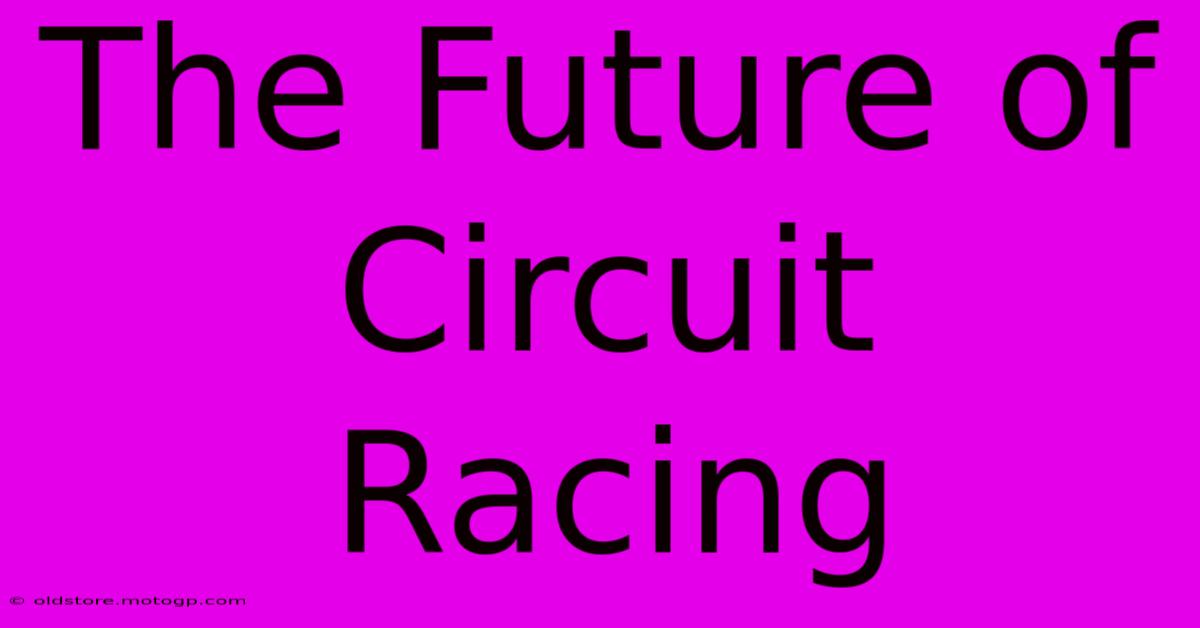The Future Of Circuit Racing

Table of Contents
The Future of Circuit Racing: Electric Power, Autonomous Tech, and Fan Engagement
The roar of internal combustion engines, a hallmark of circuit racing for over a century, is gradually fading into the background. The future of circuit racing is electric, autonomous, and deeply intertwined with innovative fan engagement. This isn't just about swapping fuel for batteries; it's a fundamental shift in the sport's technology, accessibility, and overall experience.
The Rise of Electric Vehicles (EVs) in Circuit Racing
Formula E, the all-electric single-seater championship, has already demonstrated the thrilling potential of electric racing. The instant torque, silent power delivery, and intense regenerative braking offer a unique and captivating viewing experience. Moreover, the environmental benefits are undeniable, aligning the sport with a growing global focus on sustainability. While the battery technology continues to evolve, addressing concerns around range and charging times, the performance capabilities are rapidly closing the gap on traditional gasoline-powered cars. We're likely to see an increase in electric racing series across different classes and car types in the coming years, not just replacing existing ones, but creating entirely new opportunities.
Beyond Formula E: Electric Racing's Expansion
The impact of electric power extends beyond Formula E. Manufacturers are increasingly investing in electric performance cars, which will undoubtedly influence the development of future racing series. We can anticipate more championships featuring electric touring cars, GT cars, and even hypercars, broadening the appeal and accessibility of electric motorsports to a wider audience. This growth will drive innovation in battery technology, motor design, and overall vehicle efficiency, pushing the boundaries of what's possible in electric performance.
The Autonomous Revolution: Driverless Circuit Racing?
The idea of fully autonomous circuit racing might seem futuristic, but the technology is rapidly advancing. Self-driving systems are already being tested in various motorsport contexts, primarily for safety and data collection purposes. While a completely driverless Formula 1 race is unlikely in the near future, the integration of autonomous features could significantly enhance safety, particularly in areas like accident prevention and track limit enforcement. Moreover, autonomous racing could unlock new avenues for technological innovation, pushing the boundaries of artificial intelligence and machine learning in extreme performance environments.
The Role of Human Drivers: A Collaborative Future?
It's important to clarify that the future isn't necessarily about replacing human drivers. Instead, we are likely to see a more collaborative approach, where autonomous systems assist drivers, enhancing performance and safety. Think of advanced driver-assistance systems providing real-time feedback, optimizing racing lines, and predicting opponent's maneuvers. This blend of human skill and artificial intelligence could create a new level of excitement and strategic depth in circuit racing.
Enhanced Fan Engagement: A Digital-First Approach
The future of circuit racing hinges on enhancing the fan experience. The digital revolution is transforming how fans interact with the sport, from virtual reality experiences and interactive simulations to advanced data analysis and personalized content. Live-streaming, augmented reality overlays, and detailed telemetry data provide viewers with unprecedented insights into the races. Furthermore, esports racing is gaining immense popularity, creating a new generation of engaged fans and providing an accessible entry point into the world of circuit racing.
Accessibility and Inclusivity: Breaking Down Barriers
Technological advancements can make circuit racing more accessible to a broader audience. Virtual reality allows fans to experience the thrill of racing from the driver's seat, regardless of their geographical location or physical capabilities. Sim racing platforms provide opportunities for aspiring drivers to hone their skills and compete against others, potentially leading to professional racing careers. This increased accessibility contributes to the sport's inclusivity, expanding its reach and fostering a more diverse community.
Conclusion:
The future of circuit racing is a dynamic landscape of technological innovation, enhanced fan engagement, and a commitment to sustainability. Electric vehicles, autonomous systems, and digital platforms are reshaping the sport, creating exciting new possibilities and ensuring its continued relevance and growth for generations to come. The challenge lies in embracing these changes while preserving the core elements that make circuit racing so captivating – the thrill of competition, the skill of the drivers, and the passion of the fans.

Thank you for visiting our website wich cover about The Future Of Circuit Racing. We hope the information provided has been useful to you. Feel free to contact us if you have any questions or need further assistance. See you next time and dont miss to bookmark.
Featured Posts
-
Cota Qualifying From Zero To Hero
Feb 18, 2025
-
Moto Gp Race Tracks A Global Perspective
Feb 18, 2025
-
Austin Gp Concert The Ultimate Motorsports And Music Festival
Feb 18, 2025
-
Motorcycle Grand Prix Winners Inspiring Future Generations
Feb 18, 2025
-
Moto Gp Arcade Non Stop Action
Feb 18, 2025
